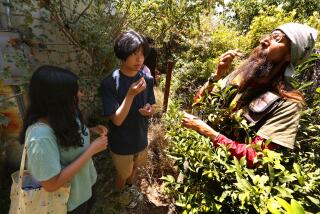Snags Arise for School Set to Open
Dissatisfied with test results of a toxic cleansing system at a new middle school, state toxics officials are asking for additional information, a potential obstacle to opening the South-Central Los Angeles campus in September, according to documents obtained Thursday.
But a far higher hurdle is the rising opposition of a community group that is vowing to block the school’s opening because of lingering concerns about the safety of the campus site and a vacant lot across East 56th Street that is being added this month to the state’s action list--the regional version of a Superfund cleanup list.
“I know we look like the bad guys who don’t want to open the school,” said Juanita Tate, executive director of Concerned Citizens of South-Central Los Angeles. “But I say: Let it stay closed until they do it right.”
Jefferson New Middle School was to open its doors July 1, but in May thousands of prospective students were told to stay at their crowded schools amid questions about whether two cancer-causing chemicals left behind by industry lurked in soil and water at the site.
The district had hoped to gain health clearance to open the $54.5-million school in September, but now--in a series of letters and memos--the state Department of Toxic Substances Control charges that there are inconsistencies and errors in tests of a system installed to clear toxic gas from the ground. It recommends further tests with the help of state regulatory agencies.
Pointing out that all the other required tests have been cleared by the state, district officials expressed optimism that the additional work could be completed quickly.
“I think we’re very close at this point,” said Dianne Doi, acting environmental health and safety director.
But the activists, who pushed hard for the new campus to be built, say they cannot in good conscience send children there until cleanup is completed on the adjacent lot that used to house a company called Hard Chrome Products. They ask: How can anyone know how safe that operation will be until it is at least planned, not to mention started?
Responsibility for such cleanups typically lies with the former property owners, although the state is in a dispute with the chrome-plating company about who caused the contamination.
Doi said she has been assured by the state that the district will be able to review cleanup plans before they are carried out.
Concerned Citizens has called a community meeting at 6 p.m. Tuesday to discuss the latest test results and the anticipated future cleanup of the Hard Chrome site. Fliers for the event at the New Hope Baptist Church are headlined “Chromium Contamination.”
The community group could prove to be a formidable opponent for the district: Six years ago it helped block the location of a hazardous waste incinerator in Vernon, in the process changing state law to require more thorough environmental reviews of such proposals.
Members said they are responding quickly to the new information about the middle school site because they do not trust the school district to protect their interests. Interaction with the district has been strained, they charged, after requested documents were not produced and deadlines were missed.
“If we’re not careful, we’ll look up and kids will be going to school over there,” said Rebecca Jones, who lives near the East 56th Street campus and hopes to send her daughter there one day.
Doi said the district has tried to be responsive, but the testing and state reviews took “longer than we had anticipated,” leading to delays in providing information to the community.
Problems at the school site in part underscore the difficulty of finding land for new schools in urban areas, where the only vacant property tends to be former industrial sites. In the case of Jefferson New Middle School, community activists opposed plans to tear down houses to make way for a school and urged the district to look for open land instead.
The school land previously housed a furniture manufacturer, which apparently used a solvent known as tetrachloroethene, or TCE, that has been linked to cancer. Tanks containing the chemical were discovered during construction, causing the district to install a gas extraction system--the system evaluated in the most recent round of tests.
Across the street from the school’s entrance is the Hard Chrome site--now an asphalt pad surrounded by a cyclone fence. There, the more dangerous hexavalent chromium contamination was found in 1993 and last year was found to have seeped into ground water far beneath the school.
But the community also has questioned why the state did not inform the district of the chromium site until last summer, long after construction had begun. It also remains unclear why neither the chromium nor the TCE contamination were uncovered in the district’s own environmental impact review.
More to Read
Sign up for Essential California
The most important California stories and recommendations in your inbox every morning.
You may occasionally receive promotional content from the Los Angeles Times.










